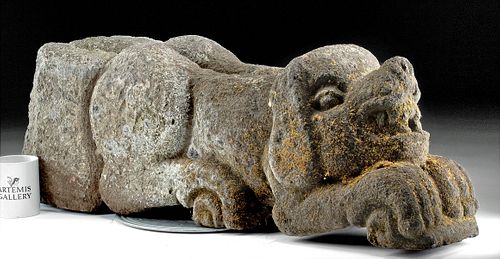Huge Teotihuacan / Aztec Stone Water Spout Zoomorph
About Seller
686 S Taylor Ave, Ste 106
Louisville, CO 80027
United States
Selling antiquities, ancient and ethnographic art online since 1993, Artemis Gallery specializes in Classical Antiquities (Egyptian, Greek, Roman, Near Eastern), Asian, Pre-Columbian, African / Tribal / Oceanographic art. Our extensive inventory includes pottery, stone, metal, wood, glass and textil...Read more
Two ways to bid:
- Leave a max absentee bid and the platform will bid on your behalf up to your maximum bid during the live auction.
- Bid live during the auction and your bids will be submitted real-time to the auctioneer.
Bid Increments
| Price | Bid Increment |
|---|---|
| $0 | $25 |
| $300 | $50 |
| $1,000 | $100 |
| $2,000 | $250 |
| $5,000 | $500 |
| $10,000 | $1,000 |
| $20,000 | $2,500 |
| $50,000 | $5,000 |
| $100,000 | $10,000 |
| $200,000 | $20,000 |
About Auction
Nov 10, 2022
Museum-worthy examples of classical antiquities (Egyptian, Greek, Roman, Near Eastern), Viking, Far East / Asian, Pre-Columbian, African / Tribal, Oceanic, Native American, Spanish Colonial, Nautical, Fossils, Ancient Jewelry, Fine / Visual Arts, so much more! Artemis Fine Arts info@artemisfinearts.com
- Lot Description
Pre-Columbian, Valley of Mexico, Teotihuacan to early Aztec culture, ca. 600 to 1400 CE. This is a superb volcanic rock carving of a recumbent dog-like or jaguar creature, with a shallow groove or water channel down its spine and an opening spout in the mouth. The animal has large, bared fangs and an upturned snout, and floppy ears which may be part of a headdress. The haunches and front paws are curled to the sides but contain a taunt- energy as if crouching to leap. Zoomorphic rainwater spouts are impressive architectural elements that not only add beauty, spiritual protection, or inspire veneration, but also serve a practical function. Diverting the water away and off the sides of the building, this preserves the masonry and stone from eroding as quickly, and the water is then accessible for drinking or cleansing as it cascades from the animal's mouth. Size: 35" L x 8" W x 11.5" H (88.9 cm x 20.3 cm x 29.2 cm)
Water is essential to every human settlement, and the mythical stories and deities that evolve around water are brought to life as these impressive fountains. Teotihuacan is the largest pre-Columbian site in the Americas, called the "City of the Gods" by the Aztecs, who were as fascinated by its ruins and lost culture as we are today. The artisans of Teotihuacan were masters at carving volcanic stone, which came from an andesite outcropping just a little over a mile south of the ancient city. Their massive Pyramid of the Sun is covered with over a million tons of carved volcanic rock. Transformational, god-like figures and skulls were common motifs, speaking to the cosmology of the people who lived there, which was in part based on human sacrifice to ensure the continuation of the agricultural cycle. Grand staircases and balustrades decorated with monumental and snarling heads of supernatural beings, the white stucco on this example suggests it may have been brightly painted at one time, adding to the awe-inspiring form. This architectural element would have been a magnificent addition to a building in a public space in the Teotihuacan / Aztec world.
Provenance: private San Francisco, California, USA collection, acquired 1970s to 2000s
All items legal to buy/sell under U.S. Statute covering cultural patrimony Code 2600, CHAPTER 14, and are guaranteed to be as described or your money back.
A Certificate of Authenticity will accompany all winning bids.
We ship worldwide and handle all shipping in-house for your convenience.
#170526Surface wear and weathering as expected with age and water exposure. Some softening of finer details, but head and body are defined and clear. Nicks and chips to high pointed areas. Lichen and moss growth on head, and remains of a white pigment across ear and body as shown.Condition
- Shipping Info
-
Artemis Gallery will no longer be able to offer in-house shipping for most international orders, as well as all oversized orders, including most paintings. These items are clearly marked in the listing as “3rd Party Shipping Required” in the listing. We have a list of recommended third party shippers to assist you in shipping to and from, and would be happy to assist you in working with them. We require a written authorization from the client to release property to any third party. You may fax a Shipping Release Form to 303-828-3235 or email your authorization to kristen@artemisgallery.com. Please note the all property must be removed from our premises within seven (7) business days following the last day of the auction.
-
- Buyer's Premium



 EUR
EUR CAD
CAD AUD
AUD GBP
GBP MXN
MXN HKD
HKD CNY
CNY MYR
MYR SEK
SEK SGD
SGD CHF
CHF THB
THB














